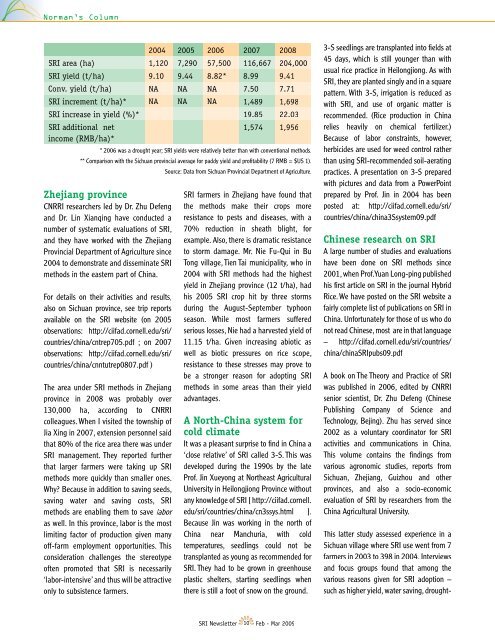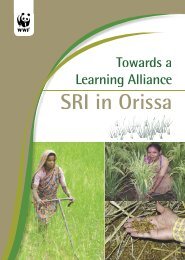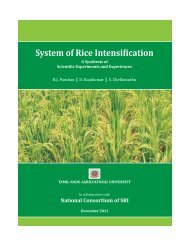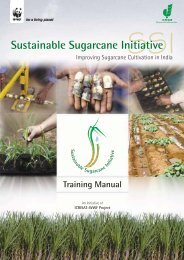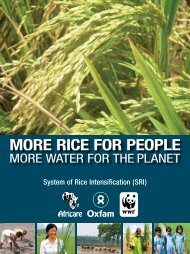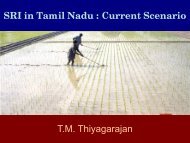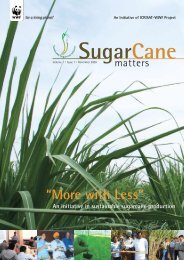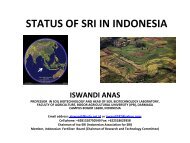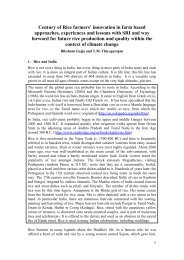Stretching Out SRI in Tamil Nadu - SRI - India
Stretching Out SRI in Tamil Nadu - SRI - India
Stretching Out SRI in Tamil Nadu - SRI - India
You also want an ePaper? Increase the reach of your titles
YUMPU automatically turns print PDFs into web optimized ePapers that Google loves.
Norman’s Column<br />
Zhejiang prov<strong>in</strong>ce<br />
CNRRI researchers led by Dr. Zhu Defeng<br />
and Dr. L<strong>in</strong> Xianq<strong>in</strong>g have conducted a<br />
number of systematic evaluations of <strong>SRI</strong>,<br />
and they have worked with the Zhejiang<br />
Prov<strong>in</strong>cial Department of Agriculture s<strong>in</strong>ce<br />
2004 to demonstrate and dissem<strong>in</strong>ate <strong>SRI</strong><br />
methods <strong>in</strong> the eastern part of Ch<strong>in</strong>a.<br />
For details on their activities and results,<br />
also on Sichuan prov<strong>in</strong>ce, see trip reports<br />
available on the <strong>SRI</strong> website (on 2005<br />
observations: http://ciifad.cornell.edu/sri/<br />
countries/ch<strong>in</strong>a/cntrep705.pdf ; on 2007<br />
observations: http://ciifad.cornell.edu/sri/<br />
countries/ch<strong>in</strong>a/cnntutrep0807.pdf )<br />
The area under <strong>SRI</strong> methods <strong>in</strong> Zhejiang<br />
prov<strong>in</strong>ce <strong>in</strong> 2008 was probably over<br />
130,000 ha, accord<strong>in</strong>g to CNRRI<br />
colleagues. When I visited the township of<br />
Jia X<strong>in</strong>g <strong>in</strong> 2007, extension personnel said<br />
that 80% of the rice area there was under<br />
<strong>SRI</strong> management. They reported further<br />
that larger farmers were tak<strong>in</strong>g up <strong>SRI</strong><br />
methods more quickly than smaller ones.<br />
Why? Because <strong>in</strong> addition to sav<strong>in</strong>g seeds,<br />
sav<strong>in</strong>g water and sav<strong>in</strong>g costs, <strong>SRI</strong><br />
methods are enabl<strong>in</strong>g them to save labor<br />
as well. In this prov<strong>in</strong>ce, labor is the most<br />
limit<strong>in</strong>g factor of production given many<br />
off-farm employment opportunities. This<br />
consideration challenges the stereotype<br />
often promoted that <strong>SRI</strong> is necessarily<br />
‘labor-<strong>in</strong>tensive’ and thus will be attractive<br />
only to subsistence farmers.<br />
2004 2005 2006 2007 2008<br />
<strong>SRI</strong> area (ha) 1,120 7,290 57,500 116,667 204,000<br />
<strong>SRI</strong> yield (t/ha) 9.10 9.44 8.82* 8.99 9.41<br />
Conv. yield (t/ha) NA NA NA 7.50 7.71<br />
<strong>SRI</strong> <strong>in</strong>crement (t/ha)* NA NA NA 1,489 1,698<br />
<strong>SRI</strong> <strong>in</strong>crease <strong>in</strong> yield (%)* 19.85 22.03<br />
<strong>SRI</strong> additional net<br />
<strong>in</strong>come (RMB/ha)*<br />
1,574 1,956<br />
* 2006 was a drought year; <strong>SRI</strong> yields were relatively better than with conventional methods.<br />
** Comparison with the Sichuan prov<strong>in</strong>cial average for paddy yield and profitability (7 RMB = $US 1).<br />
Source: Data from Sichuan Prov<strong>in</strong>cial Department of Agriculture.<br />
<strong>SRI</strong> farmers <strong>in</strong> Zhejiang have found that<br />
the methods make their crops more<br />
resistance to pests and diseases, with a<br />
70% reduction <strong>in</strong> sheath blight, for<br />
example. Also, there is dramatic resistance<br />
to storm damage. Mr. Nie Fu-Qui <strong>in</strong> Bu<br />
Tong village, Tien Tai municipality, who <strong>in</strong><br />
2004 with <strong>SRI</strong> methods had the highest<br />
yield <strong>in</strong> Zhejiang prov<strong>in</strong>ce (12 t/ha), had<br />
his 2005 <strong>SRI</strong> crop hit by three storms<br />
dur<strong>in</strong>g the August-September typhoon<br />
season. While most farmers suffered<br />
serious losses, Nie had a harvested yield of<br />
11.15 t/ha. Given <strong>in</strong>creas<strong>in</strong>g abiotic as<br />
well as biotic pressures on rice scope,<br />
resistance to these stresses may prove to<br />
be a stronger reason for adopt<strong>in</strong>g <strong>SRI</strong><br />
methods <strong>in</strong> some areas than their yield<br />
advantages.<br />
A North-Ch<strong>in</strong>a system for<br />
cold climate<br />
It was a pleasant surprise to f<strong>in</strong>d <strong>in</strong> Ch<strong>in</strong>a a<br />
‘close relative’ of <strong>SRI</strong> called 3-S. This was<br />
developed dur<strong>in</strong>g the 1990s by the late<br />
Prof. J<strong>in</strong> Xueyong at Northeast Agricultural<br />
University <strong>in</strong> Heilongjiong Prov<strong>in</strong>ce without<br />
any knowledge of <strong>SRI</strong> [ http://ciifad.cornell.<br />
edu/sri/countries/ch<strong>in</strong>a/cn3ssys.html ].<br />
Because J<strong>in</strong> was work<strong>in</strong>g <strong>in</strong> the north of<br />
Ch<strong>in</strong>a near Manchuria, with cold<br />
temperatures, seedl<strong>in</strong>gs could not be<br />
transplanted as young as recommended for<br />
<strong>SRI</strong>. They had to be grown <strong>in</strong> greenhouse<br />
plastic shelters, start<strong>in</strong>g seedl<strong>in</strong>gs when<br />
there is still a foot of snow on the ground.<br />
<strong>SRI</strong> Newsletter 10 Feb - Mar 2009<br />
3-S seedl<strong>in</strong>gs are transplanted <strong>in</strong>to fields at<br />
45 days, which is still younger than with<br />
usual rice practice <strong>in</strong> Heilongjiong. As with<br />
<strong>SRI</strong>, they are planted s<strong>in</strong>gly and <strong>in</strong> a square<br />
pattern. With 3-S, irrigation is reduced as<br />
with <strong>SRI</strong>, and use of organic matter is<br />
recommended. (Rice production <strong>in</strong> Ch<strong>in</strong>a<br />
relies heavily on chemical fertilizer.)<br />
Because of labor constra<strong>in</strong>ts, however,<br />
herbicides are used for weed control rather<br />
than us<strong>in</strong>g <strong>SRI</strong>-recommended soil-aerat<strong>in</strong>g<br />
practices. A presentation on 3-S prepared<br />
with pictures and data from a PowerPo<strong>in</strong>t<br />
prepared by Prof. J<strong>in</strong> <strong>in</strong> 2004 has been<br />
posted at: http://ciifad.cornell.edu/sri/<br />
countries/ch<strong>in</strong>a/ch<strong>in</strong>a3Ssystem09.pdf<br />
Ch<strong>in</strong>ese research on <strong>SRI</strong><br />
A large number of studies and evaluations<br />
have been done on <strong>SRI</strong> methods s<strong>in</strong>ce<br />
2001, when Prof. Yuan Long-p<strong>in</strong>g published<br />
his first article on <strong>SRI</strong> <strong>in</strong> the journal Hybrid<br />
Rice. We have posted on the <strong>SRI</strong> website a<br />
fairly complete list of publications on <strong>SRI</strong> <strong>in</strong><br />
Ch<strong>in</strong>a. Unfortunately for those of us who do<br />
not read Ch<strong>in</strong>ese, most are <strong>in</strong> that language<br />
– http://ciifad.cornell.edu/sri/countries/<br />
ch<strong>in</strong>a/ch<strong>in</strong>a<strong>SRI</strong>pubs09.pdf<br />
A book on The Theory and Practice of <strong>SRI</strong><br />
was published <strong>in</strong> 2006, edited by CNRRI<br />
senior scientist, Dr. Zhu Defeng (Ch<strong>in</strong>ese<br />
Publish<strong>in</strong>g Company of Science and<br />
Technology, Bej<strong>in</strong>g). Zhu has served s<strong>in</strong>ce<br />
2002 as a voluntary coord<strong>in</strong>ator for <strong>SRI</strong><br />
activities and communications <strong>in</strong> Ch<strong>in</strong>a.<br />
This volume conta<strong>in</strong>s the f<strong>in</strong>d<strong>in</strong>gs from<br />
various agronomic studies, reports from<br />
Sichuan, Zhejiang, Guizhou and other<br />
prov<strong>in</strong>ces, and also a socio-economic<br />
evaluation of <strong>SRI</strong> by researchers from the<br />
Ch<strong>in</strong>a Agricultural University.<br />
This latter study assessed experience <strong>in</strong> a<br />
Sichuan village where <strong>SRI</strong> use went from 7<br />
farmers <strong>in</strong> 2003 to 398 <strong>in</strong> 2004. Interviews<br />
and focus groups found that among the<br />
various reasons given for <strong>SRI</strong> adoption –<br />
such as higher yield, water sav<strong>in</strong>g, drought-


